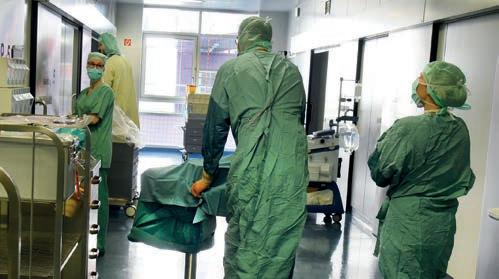HEALTH
Microbial resistance: The battle continues oe.cd/obs/2R7
©AFP/Waltraud Grubitzsch/Picture Alliance
Anne-Lise Prigent, OECD Observer
More generally, we need to take greater care of our ecosystems. Most of the genes responsible for resistance have been around for a long time, far longer than antibiotics, says Julie Louise Gerberding, vice-president at Merck. Pouring antibiotics into soil, livestock or water will just amplify this resistance. We can reduce infections with preventive measures. “Everybody’s health depends on immunisation,” insists Zsuzsanna Jakab, WHO Regional Director for Europe. There is a huge margin for increasing vaccination levels in livestock, and this could be a weapon in the fight against resistance to antimicrobials.
Healthcare budgets and facilities face an uphill battle against anti-microbial resistance. Can policymakers find a way through? A discussion at the OECD Forum 2019 spelt out some major risks if they don’t. Tuberculosis is back. We thought that with antibiotics we had more or less vanquished this titan killer by the middle of the 20th century. And yet, since the 1990s, it has re-emerged more virulently than ever. Worldwide, tuberculosis infects 10 million people every year, and kills over three million. It is thousands of years old, and has now adapted: between 2011 and 2015, two million people contracted a strain of tuberculosis that is resistant to antibiotics. Not only tuberculosis, but infected cuts, small infections that turn into epidemics—these problems that we thought we had consigned to history are now returning. Our modern medicine, all the way up to transplants, ultimately relies on a surprisingly small number of drugs, including antibiotics to prevent infections. The trouble is that their effectiveness is weakening. If we don’t take action, so-called superbug infections that are resistant to antibiotics could kill upwards of 2 million people over the next thirty years in Europe, North America and Australia alone. In OECD countries, 17% of infections are already resistant, compared to no less than 40-60% in Brazil, Indonesia and Russia, where resistance rates could increase four to seven times as fast. Of course, the more we use antibiotics, the more we encourage bacteria to mutate and develop resistance, as per the theory of evolution. But unfortunately, too many doctors continue to prescribe these drugs systematically, and in some countries they are even available over the counter. There is no need for people to turn to antibiotics at the first sneeze, participants at this OECD Forum session argued, as these should be prescribed more judiciously. Nor is it just about medicine and hospitals, since farms and our food chain also face issues. The agricultural sector accounts for between two thirds and three quarters of antibiotic consumption, Timothy Jinks, from the Wellcome Trust’s drug-resistant infections programme, pointed out. In many cases, if one animal falls ill, the entire herd is treated with antibiotics.
Simple preventive measures naturally remain essential. The biggest strides in healthcare have been made through hygiene: ensuring cleanliness, washing hands, etc. This holds for hospitals, as well as for schools and homes. For two dollars per person per year, three-quarters of deaths due to these infections could be prevented, OECD data show. A failing market? In the last 25 years, just two new second-line antibiotics have been invented for the treatment of tuberculosis, according to Serhiy Kiral, a member of the Ukrainian parliament. Most of the antibiotics used to treat the disease have been around for over 50 years, because the market is not profitable enough. For Julie Louise Gerberding, one way to solve the failing market might be a public-private coalition between governments, the private sector, philanthropists such as the Gates Foundation, and so on. The Coalition for Epidemic Preparedness Innovations was cited as an example, which is working on vaccines to prevent outbreaks of diseases such as Ebola. Another cause for concern is the chain of production. For some medicines, production is concentrated in a handful of plants. Recently, a fire in a Chinese plant led to shortages of medicines in Europe and the US. In OECD countries, life expectancy has risen, but without antibiotics, it will fall back again. Knowledge is improving and reports are being published, but public authorities must take action now. Civil society must also act in support, as they have done before with issues like malaria and AIDS. Why not antimicrobial resistance? What is clear from this OECD Forum debate is the need for investment. The private sector should help to make this happen, and public policy should make it attractive to invest in. Given the global nature of both disease and science, international co-operation will be essential if policymakers are to find a way to beat back anti-microbial resistance once and for all. References and further reading This article reflects a session of the 2019 OECD Forum, Drug-Resistant Infections & Vaccines, 21 May, see www.oecd.org/forum/programme/#!142040. OECD (2018), Stemming the Superbug Tide: Just A Few Dollars More, OECD Health Policy Studies, OECD Publishing, Paris, https://doi.org/10.1787/9789264307599-en. OECD (2018), Stopping antimicrobial resistance would cost just USD 2 per person a year, https://www.oecd.org/health/stopping-antimicrobial-resistance-would-cost-just-usd-2-perperson-a-year.htm OECD (2018), “Stopping antimicrobial resistance would cost just $2 per person a year”, media release, 7 Nov, see www.oecd.org
OECD Observer No 319-320 Q3-Q4 2019
29

















